
Toyota Times interviewed the key figure at Japan Automobile Manufacturers Association to learn about its recent organizational reform in depth and the member's thoughts behind the effort.

As was noted in a press conference held in June this year, the Japan Automobile Manufacturers Association (JAMA) launched a major organizational overhaul last year. The image that many people may have when hearing the term “industry organization” is of an advocacy group, hesitant to change, but what is it that prompted this historic organization into action?
For this article, the Toyota Times editorial team was given an opportunity to have an exclusive interview with Mr. Yoshihiro Yano, Secretary General of JAMA. He spoke candidly, revealing everything about the inner workings of JAMA, including the aims of JAMA Chairman Akio Toyoda, who is leading the transformation, the thoughts of JAMA staff, and the responsibilities that JAMA needs to fulfill.
What is the purpose of JAMA?
The history of JAMA is synonymous to the history of the struggles the Japanese automobile industry has experienced against the world.
Following defeat in World War II, Japan was placed under the administration of the General Headquarters, Supreme Commander for the Allied Powers (GHQ) and production of passenger vehicles was subjected to restrictions. This situation, coupled with a lack of materials and fuel shortages, conspired to make any meaningful business activities by Japan’s automotive industry virtually impossible.
Even in the face of this adversity, Toyota Motor Corporation’s founder, Kiichiro Toyoda, was among those who remained determined to restore the fortunes of Japan’s auto industry, and it was this strong desire that led to the establishment of the Automotive Industrial Association, the forerunner of JAMA in 1948.
Although there were still restrictions on materials, the launch of the new association spurred moves towards restarting production of automobiles in Japan. It was in that process that the Japan Small Vehicle Manufacturers Association was also established, comprised of motorcycle and minivehicle manufacturers. In 1967 the Automotive Industrial Association and the Japan Small Vehicle Manufacturers Association merged to become JAMA.
Since then, Japan’s automotive industry has faced a barrage of challenges, from the liberalization of capital and trade to the oil shock, environmental regulations, and trade frictions.
JAMA Secretary General Yano notes that, in his years working at JAMA, one episode that remains particularly strong in his memory is the “tariff issue” that arose between Japan and the U.S. In 1995, under the administration of President Bill Clinton, the U.S. government announced 100% tariffs on the Lexus and other Japanese luxury vehicles, citing Japan’s closed markets as the reason for this measure. Looking back on that time, Yano has the following to say.
Secretary General Yano
It was not only passenger vehicle manufacturers, but also truck manufacturers who came together to bear the public relations costs “for the sake of the Japanese automotive industry.” At the beginning of each fiscal year, JAMA’s budget is shared out and covered by each of our members and (although they are also JAMA members) despite the fact that the sudden extra cost burden (due to the tariffs on luxury cars) did not directly affect them, they came forward to support us. The result was that the Clinton administration withdrew the punitive tariffs.
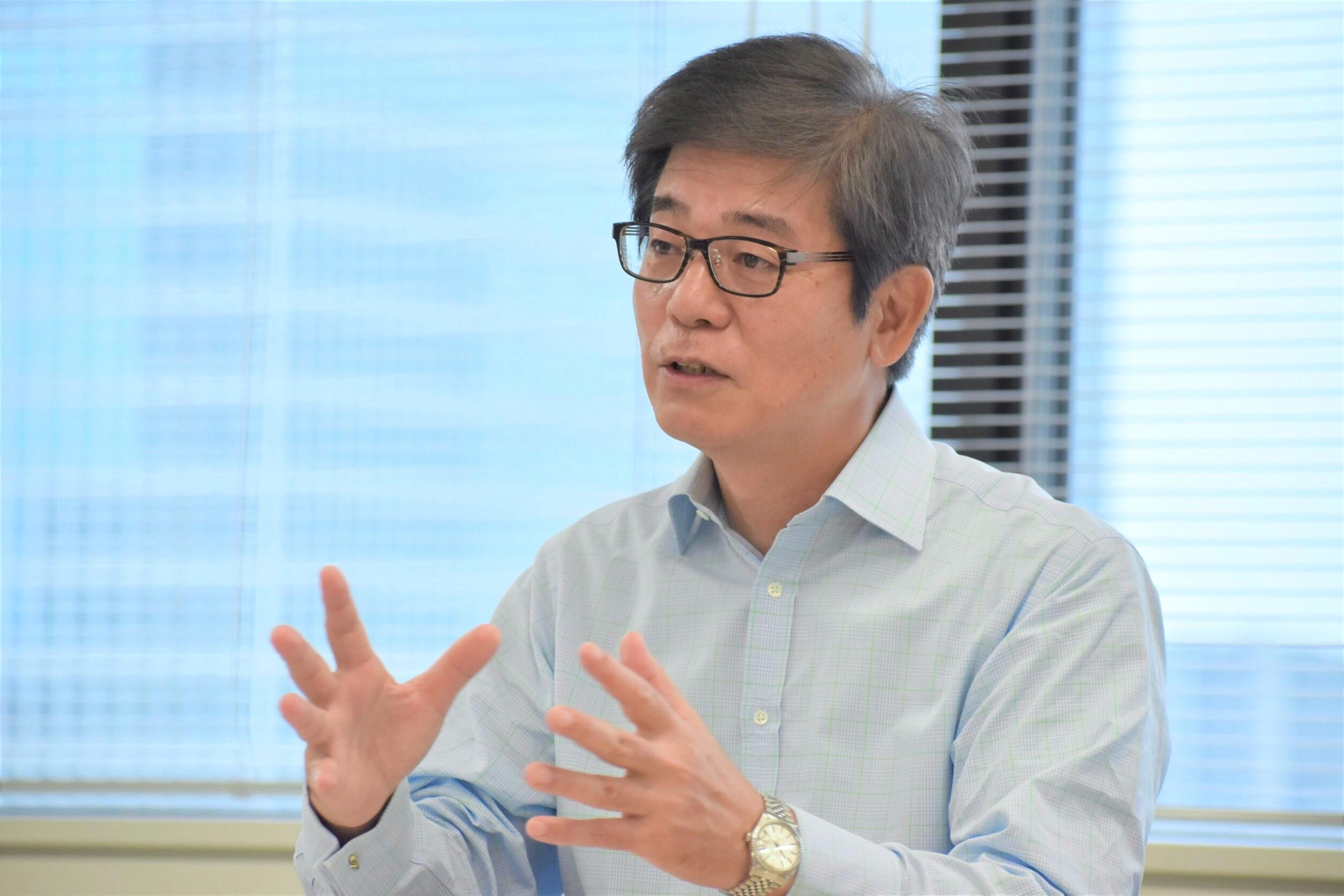
JAMA acts as a hub when dealing with major issues that no single company could handle alone, bringing the entire industry together. That is precisely why the Japanese automotive industry has been able to overcome all difficulties in its struggles with the world.
Today JAMA is facing new challenges. These include technological changes like the Connected, Autonomous, Shared, and Electrification (CASE) revolution, and new services, such as mobility as a service (MaaS). There is of course also the challenge of reducing CO2 emissions to zero and achieving carbon neutrality.
These are not challenges that can be resolved by the automotive industry single-handedly. While acting as a catalyst for various initiatives, JAMA must work to bring in new colleagues and friends and step up an all-Japan effort. In order to achieve this, JAMA needed to transition to become an organization with agility and flexibility, capable of taking on the world. Once again, the purpose and role of JAMA was called into question.
Mission to achieve reform as outlined by JAMA Chairman Toyoda
In 2018 Akio Toyoda was appointed JAMA Chairman for a second time. It was during his term of office that JAMA would face a major turning point, which came with the Tokyo Motor Show in 2019.
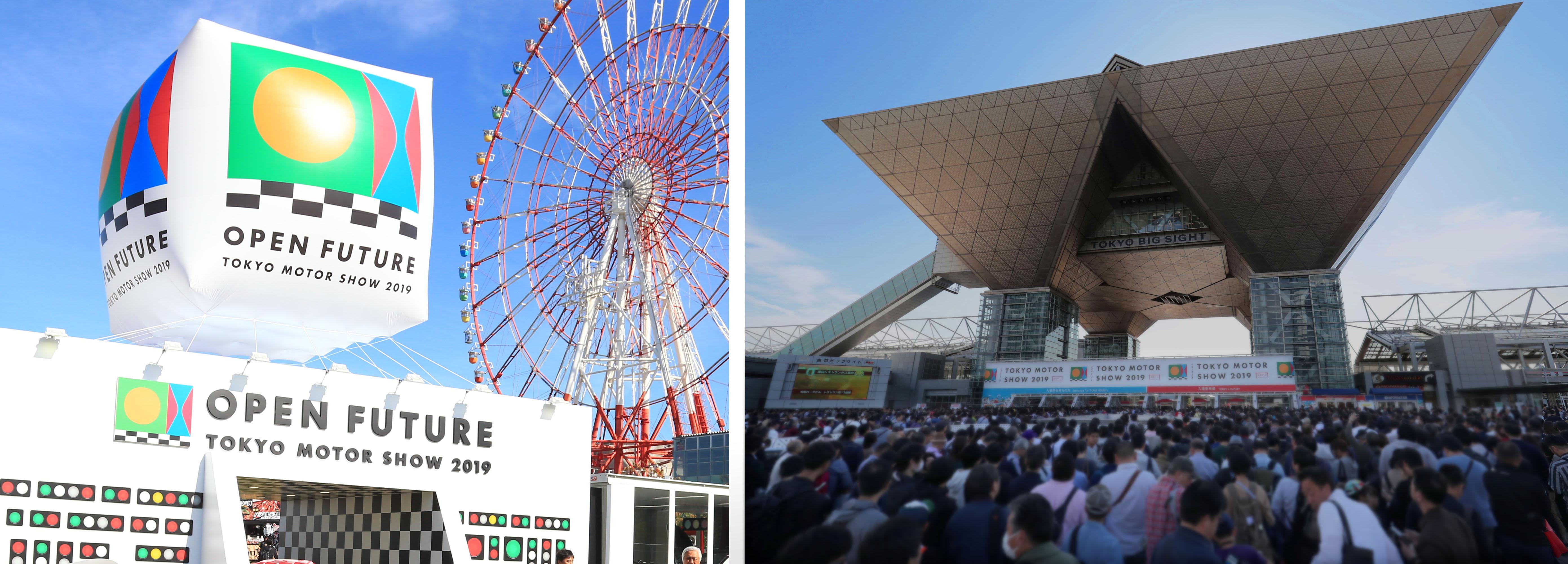
Attendee numbers at motor shows have been decreasing all around the world in recent years, and Japan is no exception. JAMA was filled with a sense of crisis that this situation should not be allowed to continue.

It was in the face of this situation that Chairman Toyoda gave directions for plans to be made to hold a Tokyo Motor Show that would bring the enjoyment of future mobility society to visitors, and also to do whatever was needed to attract one million visitors.
It was JAMA Secretary General Yano who was tasked with this challenge. He notes that he was given a great deal of freedom in planning the show. A planning working group that comprised members from JAMA and also specially selected individuals from JAMA members all came together to bounce ideas off each other and organize the event. In the end, more than 1.3 million people, including many children, came to the Tokyo Motor Show that year.
As JAMA chairman, Akio visited the venue almost every day, out of a desire to make daily improvements that would help visitors to experience an even more enjoyable time at the show. Seeing so many smiling customers’ faces only strengthened his resolve to ensure that the momentum achieved (by all JAMA members working in unison) was not merely a temporary and passing achievement. That was what marked the start of fundamental reforms at JAMA.

Akio stated that he wanted Secretary General Yano to be project leader for these reforms, given his status as a long-time employee of JAMA and someone with the most detailed knowledge of its inner workings. He set out three specific missions.

Secretary General Yano notes that, “These missions made it crystal clear what we should be aiming to achieve.” He pasted the three missions on the cover of a file that he carries with him during work hours, so that he can constantly see them and reflect on them.
Fundamental reforms, implemented at top speed
Under normal circumstances, Chairman Toyoda’s two-year term of office would have ended in 2020.
However, the global-scale upheavals of today sparked debate within JAMA about whether a term of office of two years was really the best option for Japan’s automotive industry. The result of these discussions was that Chairman Toyoda’s term of office was extended to 2022 at the request of all members.
Akio himself said, “Thanks to having served for a long time as chairman, I am capable of implementing reforms dynamically. I will push through with determination to the end of my term of office.”
Secretary General Yano also talked animatedly about the reforms. “Other than on issues of survival, (until now) we have probably never come together as closely as this. We are transitioning to become a JAMA that will be a model not only for Japan, but for the world, and that is why we are progressing reforms that will make us useful to society.”
Of course, JAMA has, to date, engaged in measures to respond to challenges and change.
But given that a new chairperson was appointed every two years, the basic organization and mindset of the organization were perpetuated without any changes, with only stopgap measures being applied to address underlying issues.
The very first thing to be done was to reform the vertically structured nature of the organization. Many companies also engage in organizational transformation through a process of trial and error. So, how was it possible for JAMA to carry through both organizational and mindset reforms in such a short time?
Moving from a focus on position to a focus on role
Back in the Board of Directors meeting in March 2020, a decision was made to implement organizational restructuring, and just half a year later, in October 2020, that new organizational structure was launched. So, what kind of verification processes and reforms were carried out during that short period of time?
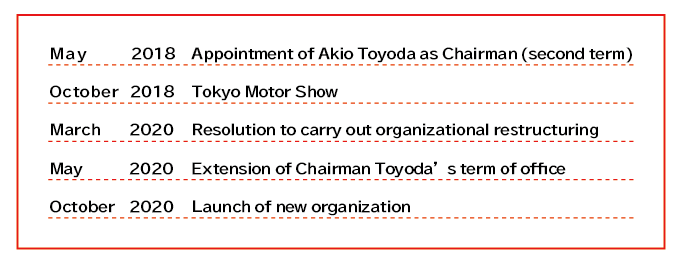
According to Secretary General Yano, the first action was to create a reform team. In addition to reviewing the committee membership structure of the approximately 300 organizations and 5,400 people from various JAMA members, the team also set about a review of various rules and regulations, including the articles of incorporation. The result of these efforts was that the number of committees and working groups was halved, through a process of consolidation.
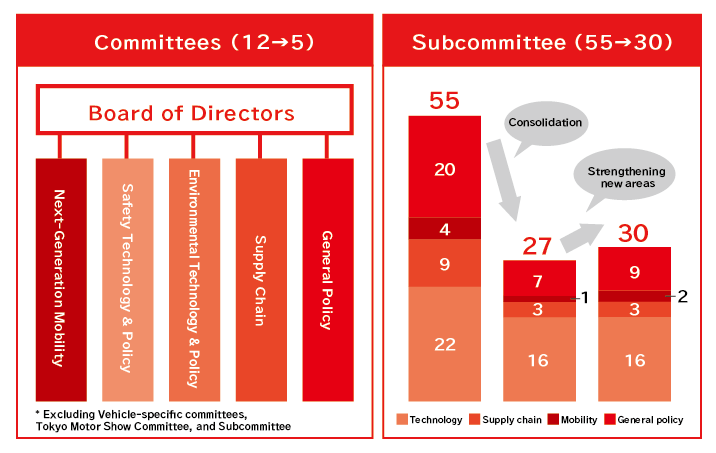
So, what was the truth behind this initiative to halve the number of committees?
Secretary General Yano
We consolidated the functions and simplified the hierarchy of the committees according to their roles. For example, whereas before public relations had been segmentalized according to function, such as “traffic safety” and “heavy duty vehicles,” we reorganized so that JAMA could be capable of uniform and integrated communications.
We created projects to address urgent issues such as carbon neutrality, going beyond the existing organizational framework, with member companies and the JAMA secretariat all working together with a sense of urgency. In terms of participating members, we did not concern ourselves about people’s position in the management hierarchy, but rather on their specialist skills. We worked on a project basis, with the aim of generating sound results.
The JAMA secretariat itself has been streamlined from nine departments to four divisions. We revised the system to become flexible, enabling teams to be formed for each project (allowing people with specialized skills to transcend vertical barriers).

Work is not advanced by a person’s “position,” but rather, members participate with a clearly defined “role” that matches their own skillset. It is this approach that enabled the restructuring to advance so quickly.
Secretary General Yano
In addition to achieving the promotion of integrated activities, we also newly established an evaluation structure for our activities, which enabled us to enhance organizational governance.

This was how JAMA was able to speed ahead towards consolidation designed to create a structure capable of generating results and allocate human resources to new areas in need of greater attention. It truly was a transformative change oriented to the future.
In terms of the reason why organizational reforms progressed so quickly, one of the biggest factors was that a clear time frame was set out from the start. Akio announced that the restructuring would be completed within half a year. This sense of urgency was based on a real fear that unless “once-in-a-century” reforms of the automotive industry were implemented without delay, Japan’s automotive industry would lose its global competitiveness.
In the course of these discussions on change, the four automobile manufacturing organizations* engaged in medical support activities and mutual aid programs in response to infections due to the COVID-19 pandemic and, following the launch of the new JAMA organization in October 2020, the Japan Automobile Dealers Association (JADA) also joined activities, which led to the involvement of the 5.5 million people working in the broad automotive industry.
*JAMA, Japan Auto Parts Industries Association (JAPIA), Japan Auto-Body Industries Association Inc. (JABIA), Japan Automotive Machinery and Tool Manufacturers Association (JAMTA)
Also, at the end of October 2020, Prime Minister Yoshihide Suga announced a national policy to achieve carbon neutrality by 2050. Thanks to JAMA’s speed in completing organizational reforms that it was possible to quickly release detailed data relating to carbon neutrality, helping the automotive industry to immediately move in unison on the issue, including the submission of specific requests to the Ministry of Economy, Trade and Industry (METI).
An overwhelming sense of “everyone being in this together”
In addition to organizational reform, another major area was to transform mindset. When asked in what specific ways the newly restructured organization has changed thanks to the clarification of roles, Secretary General Yano had the following to say.
Secretary General Yano
Previously, the Board of Directors mainly approved items that had been submitted from lower down the organizational hierarchy, which was not conducive to substantive discussion. This was a perennial situation that had continued for many years.
It was in response to this situation that roles were defined, so that the Board of Directors is defined as the decision-making body, and the committees and organizations beneath them are responsible for business execution. This redefinition enabled the Board of Directors to become a forum for discussion on important topics, rather than just a rubber-stamping body. It also helped to visualize the outcomes of our activities.
We also changed the vice chairperson structure. There are a variety of roads in Japan, and mobility has developed in ways that match these various roads and their uses. We therefore invited representatives of motorcycle manufacturers (Yamaha) and heavy-duty vehicles (Isuzu) to become vice chairpersons, recognizing their role as senior management in a mobility industry that possesses various roles.
The overall number of directors, which used to include two or more representatives from each member company, has been greatly reduced and now only the very top management at each member company are appointed to the board. This change has enabled the board members to engage in candid and future-oriented discussions, transforming the board’s nature into a dynamic decision-making body for future actions.
Secretary General Yano notes that although great strides have been made with organizational reform, reforming mindset was a little more challenging.
Secretary General Yano
In vertically structured organizations, it is inevitably the case that your work becomes trapped in the same vertically oriented channels. Also, in an organization like JAMA (with multiple member companies), responsibilities can become blurred. That is why we talked about the importance of having an overwhelming sense of “everyone being in this together.”
Chairman Toyoda himself said, “The approximately 100 employees working at JAMA are representative speakers for all of the 5.5 million people in the automotive industry nationwide. It is therefore essential for each and every person at JAMA to maintain self-awareness about what they can do to improve Japan’s automotive industry, and how JAMA can contribute to the Japanese economy.
Being able to identify with issues is key to nurturing self-awareness. We held rallies for all employees to address such topics as, “Why are we changing?” and “What position are we in?” These have not been one-off events, and we continue to convey these and other messages.
By encouraging people at JAMA to identify with the issues we face and, more broadly, reaching out to the 5.5 million people in the automotive industry, we hope that we can also encourage the Japanese public as a whole to understand and relate to the activities of JAMA.
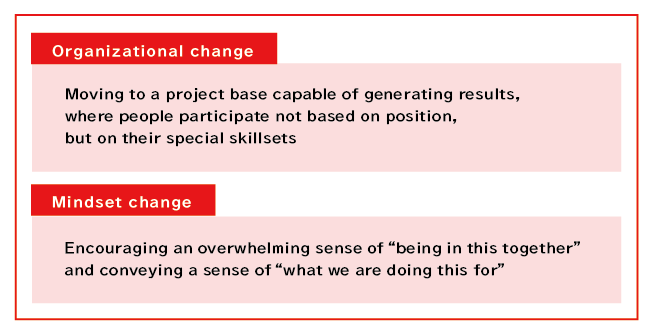
Akio said before, “Even when the chairperson changes, JAMA must remain an organization capable of continuing its mission to be of use to the automotive industry and to Japan.” If the mindset of all employees at JAMA can be transformed, it is likely that the organization will run seamlessly, even when the chairperson changes.
In January 2021 the following advertisement appeared in the Japanese press.
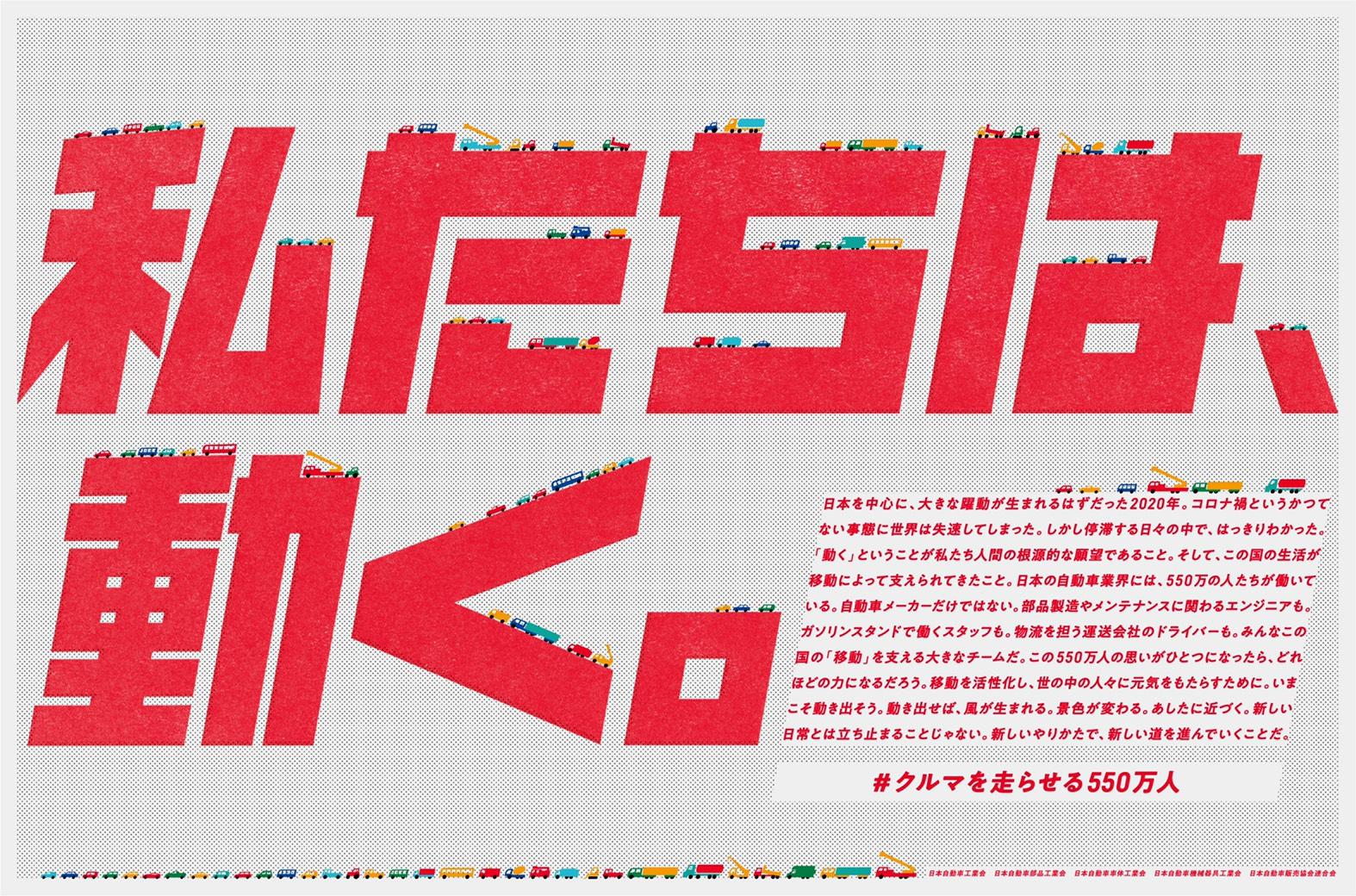
This was an initiative by not just JAMA, but the five auto-related organizations noted earlier. In a video explaining the advertisement, Chairman Toyoda spoke about the contribution that the automotive industry makes to Japan.
Chairman Toyoda
I believe that our steps bring us to another day in Japan and the world. And we can say “thank you” to each of our colleagues who take those steps. I’d like to think that we all share the same aspiration to create such an automotive industry and country together.
I’m also determined to take this step myself to realize this profound transformation. The fight against COVID-19 is becoming tougher every day, which is why we must say, “Let’s be serious, but not overwhelmed,” especially at this time. We must come together and strive to make 2021 as bright and joyous as we can.
Changing environment, working styles and outcomes
In line with these reforms, naturally the personnel system was revised. While in the past, efforts were also made to reward hard work, given the persistence of some ingrained seniority-based attitudes, evaluation methods were revised to make individual targets and outcomes more visible, and to reflect the results of hard work in treatment such as salary increases and promotions. The financial resources for this initiative were raised by reducing secretariat-related costs.
One episode that represents the transformation in employee mindset is that ideas for the JAMA’s renewed logo were not commissioned to an external company, but instead were solicited from all JAMA employees.
Although there were concerns that ideas may not be forthcoming, many employees held a desire to “change our organization for ourselves,” resulting in a total 35 proposals, representing one-third of the total workforce, being submitted, mainly from younger employees. The final version of the new logo was decided through a poll of all employees.

Akio uses every opportunity he can, in addition to JAMA press conferences, to stress the importance of relying even more on the underlying strength and potential of the 5.5 million people in the automotive industry.
In order to ensure that the automotive industry can be relied on as a strategic industry for Japan, organizational reforms are necessary to transform the environment, working styles and also outcomes. Director General of the Next-Generation Mobility Division Masami Tanaka, who has worked with Secretary General Yano on reform initiatives, notes, “It never felt like we were being forced into making reforms. We would never have achieved so much if we were being forced into action.”
Finally, Secretary General Yano says, “I am truly delighted that the JAMA that I love has become an even better organization.” As to why he likes JAMA, he has the following to say.
Secretary General Yano
Although I like cars in the first place, I also like to work together with people from different companies towards the same goal. By doing that, we are helped by many people. I get a great deal of pleasure and happiness from such work.
JAMA engages in work that companies cannot do alone for the industry and for the world. Looking ahead to the future, JAMA will continue to cooperate with other industries on major issues, like carbon neutrality. The pleasure that comes from helping each other in order to make progress is something that is likely to increase going forward.
JAMA has achieved its transformation from a zero base, looking inward to question what an industry organization should be and what purpose it should have, and changing the organization and the mindset of those who work there from the roots upward. Everything that has been achieved is for the sake of the automotive industry and society as a whole.

